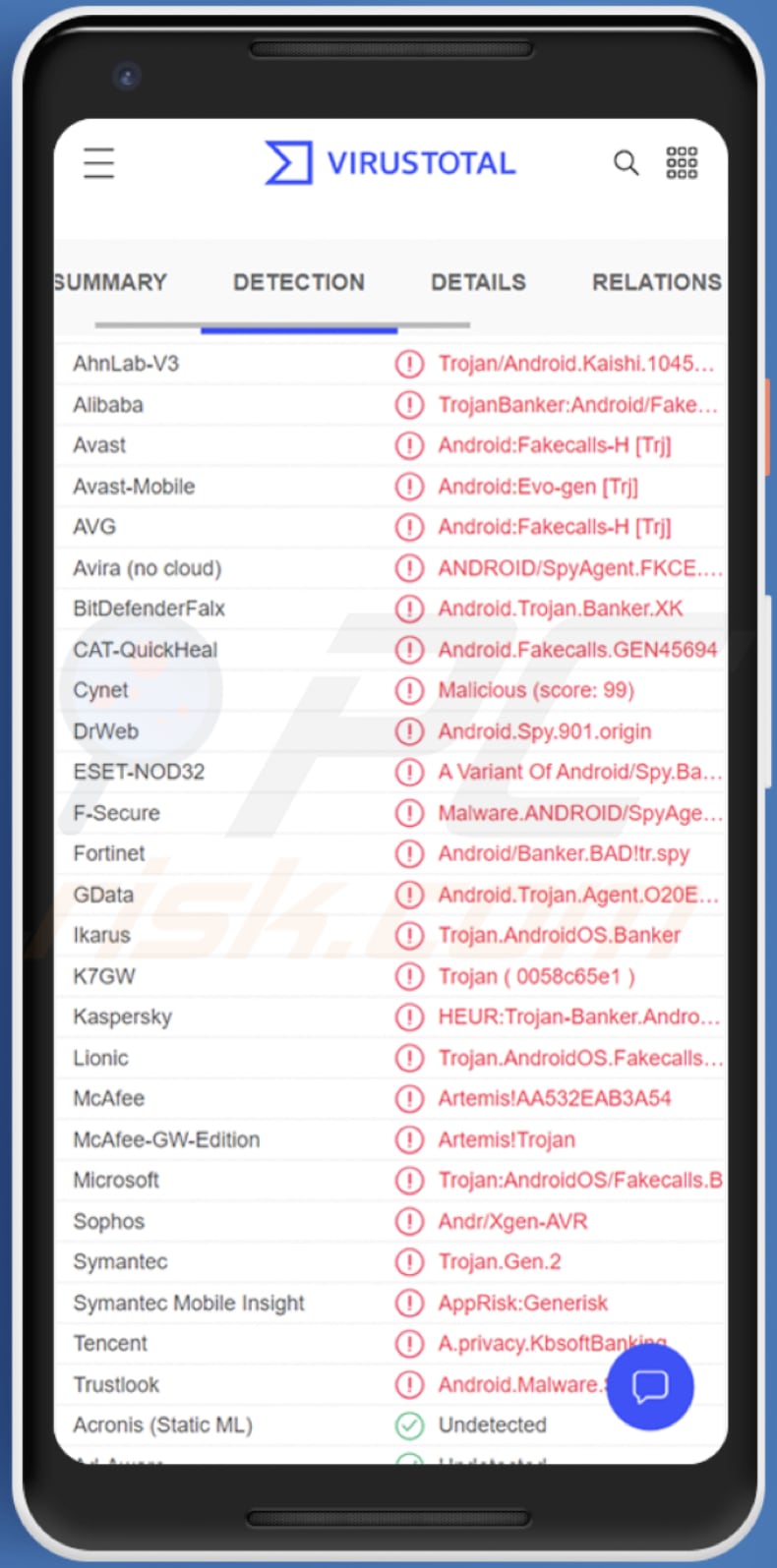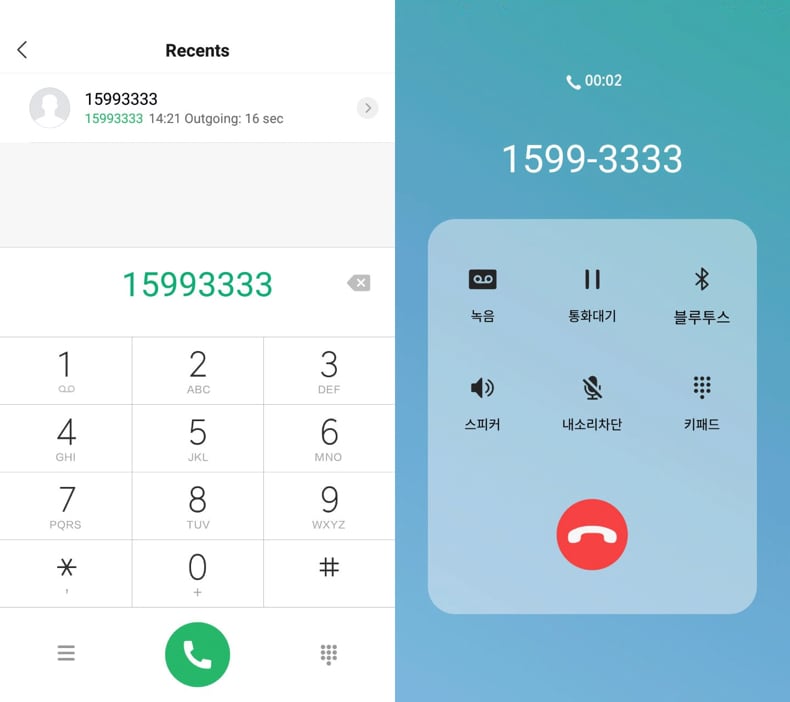Get free scan and check if your device is infected.
Remove it nowTo use full-featured product, you have to purchase a license for Combo Cleaner. Seven days free trial available. Combo Cleaner is owned and operated by RCS LT, the parent company of PCRisk.com.
What kind of malware is Fakecalls?
Fakecalls is the name of a Trojan targeting Android users. This malware imitates calls with bank employees (customer support). Fakecalls is disguised as a banking application (at least two banking apps called Kookbik Bank and KakaoBank). Cybercriminals can use Fakecalls Trojan to extract sensitive information.

Fakecalls malware in detail
We have found that Fakecalls is disguised as mobile apps of at least two popular Korean banks. Once downloaded and installed, it asks victims for permission to access contacts, microphone and camera, geolocation, and more. This Trojan can imitate conversations with customer support when victims call a bank.
More precisely, Fakecalls can display a fake call screen (with a legitimate number on it) and connect victims with cybercriminals behind this Trojan. It is important to mention that the only interface that Fakecalls can mimic at the moment is a Korean one (it cannot display a call screen in other languages).
Fakecalls can play pre-recorded audio during the conversation to make it more realistic. Also, this malware can spoof incoming calls: it allows cybercriminals to hide their number and replace it with the one owned by a legitimate bank or any other number.
| Name | Fakecalls Android malware |
| Threat Type | Android malware, malicious application, unwanted application. |
| Detection Names | Avast (Android:Fakecalls-H [Trj]), BitDefenderFalx (Android.Trojan.Banker.XK), ESET-NOD32 (A Variant Of Android/Spy.Banker.BAD), Kaspersky (HEUR:Trojan-Banker.AndroidOS.Fakecalls.h), Full List (VirusTotal) |
| Symptoms | The device is running slow, system settings are modified without user's permission, questionable applications appear, data and battery usage is increased significantly |
| Distribution methods | Fake banking applications (e.g., Kookbik Bank, KakaoBank) |
| Damage | Stolen personal information (private messages, logins/passwords, etc.), decreased device performance, battery is drained quickly, decreased Internet speed, monetary losses, stolen identity. |
| Malware Removal (Windows) |
To eliminate possible malware infections, scan your computer with legitimate antivirus software. Our security researchers recommend using Combo Cleaner. Download Combo CleanerTo use full-featured product, you have to purchase a license for Combo Cleaner. 7 days free trial available. Combo Cleaner is owned and operated by RCS LT, the parent company of PCRisk.com. |
More about the Fakecalls Trojan
Fakecalls can turn on the microphone and send recorded audio to a server controlled by the attackers. Also, it can broadcast both audio and video from the infected Android device, drop incoming calls and delete them from the history (to block and hide real calls).
Moreover, while having the permissions mentioned in the second paragraph, this malware allows threat actors to send contact lists and files from the device to their server. It also can access the call and text message history.
More examples of Android malware are SMSSpy, Octo, Escobar.
How did Fakecalls infiltrate my device?
Fakecalls imitates Kookbik Bank and KakaoBank mobile applications (there may be more imitated apps). It is likely that cybercriminals distribute them using deceptive websites, third-party marketplaces, or even upload them to Google Play.
Websites or marketplaces used to distribute fake/malicious apps can be promoted via text messages, shady ads, other untrustworthy pages, and in similar ways.
How to avoid installation of malware?
Download applications from legitimate platforms and official pages. Read reviews before downloading applications. Do not trust apps promoted on shady websites or ads appearing on pages of this kind. Do not grant permissions for questionable applications.
Do not open links or files in irrelevant emails sent from suspicious email addresses. Remember that cybercriminals disguise their emails are official letters from legitimate companies. Protect your device with reputable antivirus software. Keep the installed software up to date.
Screenshot of Fakecalls Trojan disguised as legitimate apps (Kookbik Bank on the left, KakaoBank on the right):

Screenshot of Fakecalls imitating a call screen (Korean interface):

Update March 17 2023: Newer versions of FakeCalls have implemented several new evasion techniques. One of these techniques, called "multi-disk", involves modifying the ZIP header data of the APK file to set high values for the EOCD record. This is done to confuse automated analysis tools.
The second method consists of manipulating the AndroidManifest.xml file to obscure the starting marker, altering the structure of the strings and styles, and meddling with the offset of the last string to yield a wrong interpretation.
The third evasion method entails adding numerous files inside nested directories within the APK's asset folder. As a result, the file names and paths exceed 300 characters.
Update November 6, 2024 – new versions of the Fakecalls trojan have been discovered. In addition to the previously possessed capabilities, these variants can intercept incoming/outgoing calls and reroute them to numbers belonging to the cyber criminals, not just prompt victims to call those spoofed on the display. Said versions are also able to monitor Bluetooth statuses and the device screen state.
Quick menu:
- Introduction
- How to delete browsing history from the Chrome web browser?
- How to disable browser notifications in the Chrome web browser?
- How to reset the Chrome web browser?
- How to delete browsing history from the Firefox web browser?
- How to disable browser notifications in the Firefox web browser?
- How to reset the Firefox web browser?
- How to uninstall potentially unwanted and/or malicious applications?
- How to boot the Android device in "Safe Mode"?
- How to check the battery usage of various applications?
- How to check the data usage of various applications?
- How to install the latest software updates?
- How to reset the system to its default state?
- How to disable applications that have administrator privileges?
Delete browsing history from the Chrome web browser:

Tap the "Menu" button (three dots on the right-upper corner of the screen) and select "History" in the opened dropdown menu.

Tap "Clear browsing data", select "ADVANCED" tab, choose the time range and data types you want to delete and tap "Clear data".
Disable browser notifications in the Chrome web browser:

Tap the "Menu" button (three dots on the right-upper corner of the screen) and select "Settings" in the opened dropdown menu.

Scroll down until you see "Site settings" option and tap it. Scroll down until you see "Notifications" option and tap it.

Find the websites that deliver browser notifications, tap on them and click "Clear & reset". This will remove permissions granted for these websites to deliver notifications. However, once you visit the same site again, it may ask for a permission again. You can choose whether to give these permissions or not (if you choose to decline the website will go to "Blocked" section and will no longer ask you for the permission).
Reset the Chrome web browser:

Go to "Settings", scroll down until you see "Apps" and tap it.

Scroll down until you find "Chrome" application, select it and tap "Storage" option.

Tap "MANAGE STORAGE", then "CLEAR ALL DATA" and confirm the action by taping "OK". Note that resetting the browser will eliminate all data stored within. This means that all saved logins/passwords, browsing history, non-default settings and other data will be deleted. You will also have to re-login into all websites as well.
Delete browsing history from the Firefox web browser:

Tap the "Menu" button (three dots on the right-upper corner of the screen) and select "History" in the opened dropdown menu.

Scroll down until you see "Clear private data" and tap it. Select data types you want to remove and tap "CLEAR DATA".
Disable browser notifications in the Firefox web browser:

Visit the website that is delivering browser notifications, tap the icon displayed on the left of URL bar (the icon will not necessarily be a "Lock") and select "Edit Site Settings".

In the opened pop-up opt-in the "Notifications" option and tap "CLEAR".
Reset the Firefox web browser:

Go to "Settings", scroll down until you see "Apps" and tap it.

Scroll down until you find "Firefox" application, select it and tap "Storage" option.

Tap "CLEAR DATA" and confirm the action by taping "DELETE". Note that resetting the browser will eliminate all data stored within. This means that all saved logins/passwords, browsing history, non-default settings and other data will be deleted. You will also have to re-login into all websites as well.
Uninstall potentially unwanted and/or malicious applications:

Go to "Settings", scroll down until you see "Apps" and tap it.

Scroll down until you see a potentially unwanted and/or malicious application, select it and tap "Uninstall". If, for some reason, you are unable to remove the selected app (e.g., you are prompted with an error message), you should try using the "Safe Mode".
Boot the Android device in "Safe Mode":
The "Safe Mode" in Android operating system temporarily disables all third-party applications from running. Using this mode is a good way to diagnose and solve various issues (e.g., remove malicious applications that prevent users you from doing so when the device is running "normally").

Push the "Power" button and hold it until you see the "Power off" screen. Tap the "Power off" icon and hold it. After a few seconds the "Safe Mode" option will appear and you'll be able run it by restarting the device.
Check the battery usage of various applications:

Go to "Settings", scroll down until you see "Device maintenance" and tap it.

Tap "Battery" and check the usage of each application. Legitimate/genuine applications are designed to use as low energy as possible in order to provide the best user experience and to save power. Therefore, high battery usage may indicate that the application is malicious.
Check the data usage of various applications:

Go to "Settings", scroll down until you see "Connections" and tap it.

Scroll down until you see "Data usage" and select this option. As with battery, legitimate/genuine applications are designed to minimize data usage as much as possible. This means that huge data usage may indicate presence of malicious application. Note that some malicious applications might be designed to operate when the device is connected to wireless network only. For this reason, you should check both Mobile and Wi-Fi data usage.

If you find an application that uses a lot of data even though you never use it, then we strongly advise you to uninstall it as soon as possible.
Install the latest software updates:
Keeping the software up-to-date is a good practice when it comes to device safety. The device manufacturers are continually releasing various security patches and Android updates in order to fix errors and bugs that can be abused by cyber criminals. An outdated system is way more vulnerable, which is why you should always be sure that your device's software is up-to-date.

Go to "Settings", scroll down until you see "Software update" and tap it.

Tap "Download updates manually" and check if there are any updates available. If so, install them immediately. We also recommend to enable the "Download updates automatically" option - it will enable the system to notify you once an update is released and/or install it automatically.
Reset the system to its default state:
Performing a "Factory Reset" is a good way to remove all unwanted applications, restore system's settings to default and clean the device in general. However, you must keep in mind that all data within the device will be deleted, including photos, video/audio files, phone numbers (stored within the device, not the SIM card), SMS messages, and so forth. In other words, the device will be restored to its primal state.
You can also restore the basic system settings and/or simply network settings as well.

Go to "Settings", scroll down until you see "About phone" and tap it.

Scroll down until you see "Reset" and tap it. Now choose the action you want to perform:
"Reset settings" - restore all system settings to default;
"Reset network settings" - restore all network-related settings to default;
"Factory data reset" - reset the entire system and completely delete all stored data;
Disable applications that have administrator privileges:
If a malicious application gets administrator-level privileges it can seriously damage the system. To keep the device as safe as possible you should always check what apps have such privileges and disable the ones that shouldn't.

Go to "Settings", scroll down until you see "Lock screen and security" and tap it.

Scroll down until you see "Other security settings", tap it and then tap "Device admin apps".

Identify applications that should not have administrator privileges, tap them and then tap "DEACTIVATE".
Frequently Asked Questions (FAQ)
My device is infected with malware, should I format my storage device to get rid of it?
In most cases, it is not necessary to format the infected storage device to get rid of malware.
What are the biggest issues that malware can cause?
Having a device infected with malware can cause problems such as identity theft, monetary losses, decreased device performance, further infections, etc.
What is the purpose of Fakecalls malware?
This malware displays a fake call screen to imitate outgoing and incoming bank customer support calls. Cybercriminals behind it pretend to be bank employees. They can use this malware to extract sensitive information. Additionally, Fakecalls can access contact lists, files, call history, and record audio via the microphone. More information about this Trojan is provided in the article above.
How did a malware infiltrate my computer?
Fakecalls malware is distributed by disguising it as a legitimate mobile banking app (e.g., Kookbik Bank or KakaoBank banking app). Pretty often, trojanized apps are distributed via shady websites, third-party marketlaces, or Google Play.
Will Combo Cleaner protect me from malware?
Yes, Combo Cleaner can detect and eliminate almost all known malware. If a device is infected with high-end malware, it must be scanned using a full scan option. Malware of this kind usually hides deep in the system. Thus, it cannot be detected by running a quick scan.
Share:

Tomas Meskauskas
Expert security researcher, professional malware analyst
I am passionate about computer security and technology. I have an experience of over 10 years working in various companies related to computer technical issue solving and Internet security. I have been working as an author and editor for pcrisk.com since 2010. Follow me on Twitter and LinkedIn to stay informed about the latest online security threats.
PCrisk security portal is brought by a company RCS LT.
Joined forces of security researchers help educate computer users about the latest online security threats. More information about the company RCS LT.
Our malware removal guides are free. However, if you want to support us you can send us a donation.
DonatePCrisk security portal is brought by a company RCS LT.
Joined forces of security researchers help educate computer users about the latest online security threats. More information about the company RCS LT.
Our malware removal guides are free. However, if you want to support us you can send us a donation.
Donate
▼ Show Discussion